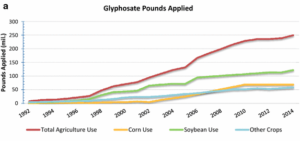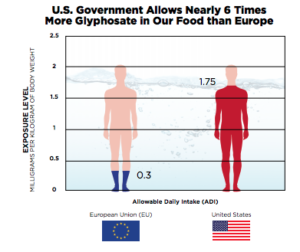Glyphosate: A Closer Look At America’s Favorite Pesticide
Welcome to our informational page on glyphosate, “America’s Favorite Pesticide…”
-The below information on human health risks is contained in this printable brochure. To request printed copies to distribute in your community, please contact us.
-Read the NOFA/Mass statement on glyphosate (Dec. 2018) at the bottom of this page.
-To learn about how you can plug into our state-wide network of local activists working to protect their communities from pesticides, protect pollinators and promote organic practices, please click here.
-To learn about pending state legislation regarding glyphosate, please visit and share this action page (and then send a message/call your legislators).
What is glyphosate?
More commonly referred to as Roundup, glyphosate was first patented in 1974 as an industrial pipe cleaner. It is now the most widely used herbicide in the world: it is used to kill weeds in fields growing genetically engineered crops like soy, corn, and canola and is often applied to non-GMO grain and other crops just prior to harvest, also as a desiccant. It is also widely used for weed control in landscapes, lawns, golf courses, and schools. Numerous studies show that even small doses of glyphosate are responsible for alarming health and environmental impacts. Research even shows that pesticides like glyphosate harm healthy soil communities, central players in soil carbon sequestration, a critical solution to climate change.
By The Numbers

(click here for the source of the data in the above graph)
- America applied 1.8 million tons of glyphosate to agricultural land from 1974 to 2016. (Clarification: This figure reflects the weight of glyphosate, not including the full formulation, which is even more toxic.)
- Since 1995, the year when GMO crops started to hit the market, glyphosate use has increased 15-fold
- GMO soybeans receive more glyphosate treatment than any other crop. In 2014, GMO soybeans received half of all applications of glyphosate on major crops in the U.S.
- The daily allowed exposure level in the U.S. is 6X greater than what is allowed in Europe

Source: Food Democracy Now! “Glyphosate: Unsafe On Any Plate”
Note: While the EU has taken a much more cautious approach to “standards” for allowable contamination, this is a bureaucratic standard not based in science. There is no truly acceptable level of glyphosate contamination in our food.
Glyphosate Is In Your Food

The USDA quietly dropped a plan to start testing food for residues of glyphosate in 2017. The FDA began a limited testing program in 2016, but the effort was soon suspended. Glyphosate cannot be washed off of produce, and residues are not necessarily destroyed by cooking. A 2016 study by Food Democracy Now! and The Detox Project comparing over two dozen common processed foods found that all of them had some level of glyphosate residues. The highest foods tended to be those that used cereal crops, presumably because they were treated with glyphosate used as a desiccant just before harvest. Some of the foods with alarmingly high residue levels were:
Glyphosate Is In Your Body
Contrary to what Monsanto wants us to think, glyphosate does not break down rapidly in the environment. Recent studies have found glyphosate residues in lakes, rivers, rainwater, soil and in human urine.
“Chronically ill humans showed significantly higher glyphosate residues in urine than healthy populations. The presence of glyphosate residues in both humans and animals could haul the entire population toward numerous health hazards….Global regulations for the use of glyphosate may have to be re-evaluated.”
-Kruger & Scheldorn, ENVIRONMENTAL & ANALYTICAL TOXICOLOGY
Test yourself for glyphosate – NOFA/Mass is partnered with HRI Labs to provide at-home urine and water test kits: http://bit.ly/HRI_NOFA – use discount code “NOFAMASS”
Glyphosate’s Impact On Your Health
Exposed before birth: A birth cohort study in Indiana published in 2017 found detectable levels of glyphosate in more than 90% of the pregnant women tested and found the levels were significantly correlated with shortened pregnancy lengths.
Endocrine Disruption: Even at very low concentrations glyphosate interferes with the proper functioning and production of hormones.
Cancer: In 2015, the World Health Organization’s International Agency for Research on Cancer (IARC) declared glyphosate to be a “probable human carcinogen.” Many scientists, including scientists at the EPA, concur with this assessment. A 2018 jury trial in California resulted in a $289 million dollar award to a landscaper dying of non-Hodgkins Lymphoma. Monsanto/Bayer now faces over eighteen thousand similar lawsuits.
Generational impacts: A 2019 study in a Nature journal reported increases in obesity, reproductive and kidney diseases, and other problems in the second- and third-generation offspring of rats exposed to glyphosate.
Gut Microbiome Disruptor: A 2018 rat study conducted by the Ramazzini Institute reported that low-dose exposures to Roundup at levels considered safe significantly altered the gut microbiota in some of the rat pups. Another 2018 study reported that higher levels of glyphosate administered to mice disrupted the gut microbiota and caused anxiety and depression-like behaviors.
Non-Alcoholic Fatty Liver Disease: A 2017 study showed that even in very small doses, glyphosate can cause the liver to swell up and develop Non-Alcoholic Fatty Liver Disease (NAFLD). Symptoms of NAFLD include fatigue, weakness, weight loss, loss of appetite, nausea, abdominal pain, spider-like blood vessels, yellowing of the skin and eyes (jaundice), itching, fluid buildup and swelling of the legs and abdomen, and mental confusion.
Nutrient Chelator: Glyphosate is known to bind with minerals including zinc and manganese, which are essential for animal and human nutrition and mineral absorption.
Glyphosate’s Impact on the Environment
Glyphosate is Widespread in the Environment
- Glyphosate and/or AMPA (a degraded form of glyphosate) were detected commonly in surface waters (59 percent of 470 sites), and infrequently in groundwater or soil water (8.4 percent of 820 sites).
- Glyphosate was detected in more than 50 percent of soil and sediment samples, and water samples from ditches and drains, precipitation, large rivers, and streams.
- Glyphosate was detected in less than 40 percent of water samples from lakes, ponds, wetlands.
- AMPA was detected more frequently than glyphosate in all environmental settings except lakes, ponds, and wetlands.
- AMPA was detected in more than 80 percent of wastewater treatment plant samples; while glyphosate was detected in only about 10 percent of those samples.
- Data from nine surface-water sites sampled repeatedly indicate that glyphosate and AMPA detection frequency, median concentrations, and loads are higher late in the study period (2006-2010) than early (2001-2005).
Glyphosate and AMPA were detected frequently in soils and sediment, ditches and drains, precipitation, rivers, and streams; and less frequently in lakes, ponds, and wetlands; soil water; and groundwater. Concentrations of glyphosate were below the levels of concern for humans or wildlife; however, pesticides are often detected in mixtures. Ecosystem effects of chronic low‐level exposures to pesticide mixtures are uncertain. The environmental health risk of low‐level detections of glyphosate, AMPA, and associated adjuvants and mixtures remain to be determined.
Source: USGS, 2014
Loss of Pollinator Habitat
The increased use of glyphosate-resistant crops has led to declines in pollinator habitat.
“Milkweed used to be found scattered throughout the agricultural Midwest in native prairies as well as in corn and soy fields—with monarchs actually often laying more eggs on milkweeds in farm fields. However, in the late 90s, agribusiness companies like Monsanto began genetically engineering crops to withstand the application of glyphosate, an herbicide that Monsanto also produced. These “herbicide tolerant” genes allowed farmers to spray glyphosate in their fields without harming their crops.
“The result? Glyphosate use skyrocketed, virtually eliminating milkweed from agricultural fields across the Midwest—a key area to the monarch butterfly’s annual migration. With the loss of milkweed, the monarch population began a steep decline – dropping over 80% in the last 20 years. The monarch butterfly is now being considered for protection under the Endangered Species Act.”
Source: Report: Monarchs, Other Species Endangered by Pesticides (NRDC, 2019)
The Rise of Superweeds
The overuse of glyphosate has resulted in the evolution of weeds which can withstand the pesticide, often leading to the use of more toxic pesticide combinations.
“Since the introduction of glyphosate-resistant crops, about 38 weed species worldwide have been identified that have developed resistance to glyphosate. As a result, these so-called superweeds can continue to infest fields and siphon nutrients from the valuable crops planted there, leading farmers to use other costlier – and potentially harsher – herbicides to control them.”
Source: Michigan State University, 2018
Impact on Endangered Species
Glyphosate is likely to adversely affect 93% of threatened and endangered species, according to a draft biological evaluation from the US Environmental Protection Agency released on Nov. 25, 2021.
Environmental groups are welcoming the assessment after waiting years for it. A series of lawsuits by the Center for Biological Diversity led to an agreement with the EPA in 2016 to begin the process of evaluating the impacts of glyphosate and atrazine on endangered species. Without that agreement, the EPA probably would not have conducted the analysis. The agency has repeatedly failed to consider risks to endangered species when it registers and reregisters pesticides.
“The hideous impacts of glyphosate on the nation’s most endangered species are impossible to ignore now,” Lori Ann Burd, environmental health program director at the Center for Biological Diversity, says in a statement. “Glyphosate use is so widespread that even the EPA’s notoriously industry-friendly pesticide office had to conclude that there are hardly any endangered species that can manage to evade its toxic impacts.”
Source: ACS Chemical and Engineering News, Nov. 30, 2020.
A 2015 study found that “honeybee navigation is affected by ingesting traces of the most widely used herbicide worldwide, with potential long-term negative consequences for colony foraging success.”
Source: Sol Balbuena, 2015. “Effects of sublethal doses of glyphosate on honeybee navigation”
How Can You Avoid Glyphosate?
Reducing glyphosate exposure is not that hard if you look closely at food labels or buy from trusted producers. The easiest ways to avoid the pesticide are to:
Buy Certified Organic
Since most of us don’t have the time or the opportunity to buy most of our food directly from farmers, the easiest way to avoid glyphosate is to look for the “Certified Organic” label when shopping. It’s worth noting that Organic food is not guaranteed to be glyphosate-free. While use is prohibited, drift from neighboring fields is possible.
Certified Glyphosate Residue Free
You can also look for a new label that certifies a food to be glyphosate-free. This label guarantees an even lower glyphosate threshold than the Organic label.
Buy Direct From A Glyphosate-Free Farm
Many farmers are happy to tell you if they use glyphosate or other pesticides. Next time you go to a farmers market or farm stand, just ask! By supporting farmers who are looking out for our health, we can push the industry towards a safer future.
Find Alternatives To Glyphosate On Your Property
Healthy soils will have less weeds, and biological pest control provides proven methods for non-toxic weed management. Consider flame weeding, steaming, using organic herbicides, or renting goats before making the decision to use glyphosate. If you work with a landscaper, make sure you ask them about their practices before enlisting their services. See this guide for resources on alternatives.
A Path Forward
Communities across the country are deciding to take action against biocides like glyphosate and the dangers they pose to humans and wildlife. By using tools like local municipal ordinances and resolutions, cities and town governments can promote organic landcare practices, limit pesticide use, and protect pollinators and sensitive ecosystems.
The process of enacting city or town policies usually starts with a handful of passionate citizen activists who want to create a safer, healthier community. Want to get active in your community? We want to help. NOFA/Mass is partnered with Toxics Action Center, Regeneration Massachusetts and others to help equip local activists with the tools they need to pass local ordinances to reduce pesticides in their communities.
Join our pesticide and pollinator organizing network!
NOFA/Mass envisions a commonwealth of people working together to create healthy landscapes that feed our communities and restore our environment. The use of toxic and persistent chemicals on landscapes, be they schools, playgrounds, municipal properties, community gardens or farms, is not compatible with that vision.
We are excited to now be joining forces with other organizations across the commonwealth at this critical moment of heightened awareness of the dangers presented by our society’s over-reliance and abuse of synthetic biocides like glyphosate and neonicotinoids (biocide is the most general term for a poisonous substance, and also means “the destruction of life” – appropriate!).
Click here for more details on how to get organizing in your community.
NOFA/Mass Statement on Glyphosate (December 2018)
NOFA/Mass envisions a commonwealth of people working together to create healthy landscapes that feed our communities and restore our environment. The indiscriminate use of toxic and persistent chemicals on landscapes, be they schools, playgrounds, municipal properties, community gardens or farms, is not compatible with that vision. We call for an end to the use of glyphosate in our communities and in our food supply.
Glyphosate poses unacceptable risks to human health, as well as to the health of non-target soil microbiology, insects and pollinators. This broad-spectrum herbicide, the most commonly used in the United States, is not just an herbicide, it is a biocide (life-killing). Glyphosate has been determined by the World Health Organization to be a probable human carcinogen.[1] Converging lines of evidence also associate glyphosate with endocrine disruption,[2] liver disease,[3] birth defects, reproductive problems,[4],[5] and disruption to gut microbiota.[6] It has also been shown to impact populations of earthworms and microbes in soil[7],[8],[9] and to damage the gut microbiota of honey bees.[10]
In August 2018, a California Superior Court ruled that Monsanto knowingly and deliberately suppressed research that found that glyphosate-based weed killers (including Roundup®) increase the risk of non-Hodgkin lymphoma, a cancer of the lymph system. The proceedings and evidence from this lawsuit have been collected and published by the plaintiff’s legal team and U.S. Right to Know as The Monsanto Papers.[11] There are currently an estimated 9,300 lawsuits pending against Bayer (which recently acquired Monsanto) alleging that the plaintiffs’ exposure to glyphosate caused their or their loved ones’ non-Hodgkin lymphoma.
Glyphosate is often assumed to be a necessity, both agriculturally and in the control of invasive plants. However, people were growing food and controlling invasive species before the product was introduced in 1975. Because of its widespread overuse, as of 2013 more than 70 million acres of U.S. agricultural land were burdened by glyphosate-resistant weeds, often resulting in the use of even more deadly chemicals[12].
The overuse of glyphosate and other biocides is a major factor in our national and global health and ecological crises, from the loss of biodiversity to rising levels of cancer and autoimmune disorders. They must be phased out wherever possible, and we should aspire to support regenerative organic solutions instead.
We do not need to wait for the government to take action: we have the power to stop buying food grown using glyphosate, to promote alternative management of invasive species, to pass local policies banning its use on school playgrounds and parks, and to educate our municipal governments about how to manage their lands without it.
[1] Guyton, K.Z., et al. on behalf of IARC. 2015. Carcinogenicity of Tetrachlorvinphos, Parathion, Malathion, Diazinon, and Glyphosate. The Lancet Oncology. doi:10.1016/S147-2045(15)70134-8.
[2] Gasnier, C., et al. 2009. Glyphosate-based herbicides are toxic and endocrine disruptors in human cell lines. Toxicology, 262(3), pp. 184-91. doi:10.1016/j.tox.2009.06.006.
[3] Mesnage, R., et al. 2017. Multiomics reveal non-alcoholic fatty liver disease in rats following chronic exposure to an ultra-low dose of Roundup herbicide. Scientific Reports, 7, 39328. doi:10.1038/srep39328.
[4] de Araujo, J. S. A., et al. 2016. Glyphosate and adverse pregnancy outcomes, a systematic review of observational studies. BMC Public Health, 16, 472. doi:10.1186/s12889-016-3153-3.
[5] Benachour, N. & Séralini, G. 2009. Glyphosate Formulations Induce Apoptosis and Necrosis in Human Umbilical, Embryonic, and Placental Cells. Chem. Res. Toxicol, 22, 1, 97-105. doi: 10.1021/tx800218n.
[6] Claus, S., et al. 2016. The gut microbiota: a major player in the toxicity of environmental pollutants? npj Biofilms and Microbiomes, 2, 16003. doi:10.1038/npjbiofilms.2016.3.
[7] Newman, M., et al. 2015. Glyphosate effects on soil rhizosphere-associated bacterial communities. Sci. of the Total Envt., 543, A, pp. 155-60. doi:10.1016/j.scitotenv.2015.11.008.
[8] Zaller, J., et al. 2014. Glyphosate herbicide affects belowground interactions between earthworms and symbiotic mycorrhizal fungi in a model ecosystem. Scientific Reports, 4, 5634. doi:10.1038/srep05634.
[9] Soil Association. The impact of glyphosate on soil health: The evidence to date. https://www.soilassociation.org/media/7202/glyphosate-and-soil-health-full-report.pdf.
[10] Motta, E., et al. 2018. Glyphosate perturbs the gut microbiota of honey bees. PNAS, 115, 41, 10305-10310. doi:10.1073/pnas.1803880115.
[11] U.S. Right to Know, The Monsanto Papers: Roundup (Glyphosate) Cancer Case Key Documents & Analysis, https://usrtk.org/pesticides/mdl-monsanto-glyphosate-cancer-case-key-documents-analysis/.
[12] Global Agriculture, 2017. “Herbicide-resistant superweeds on the rise in U.S. Midwest, university report” https://www.globalagriculture.org/whats-new/news/en/32402.html
